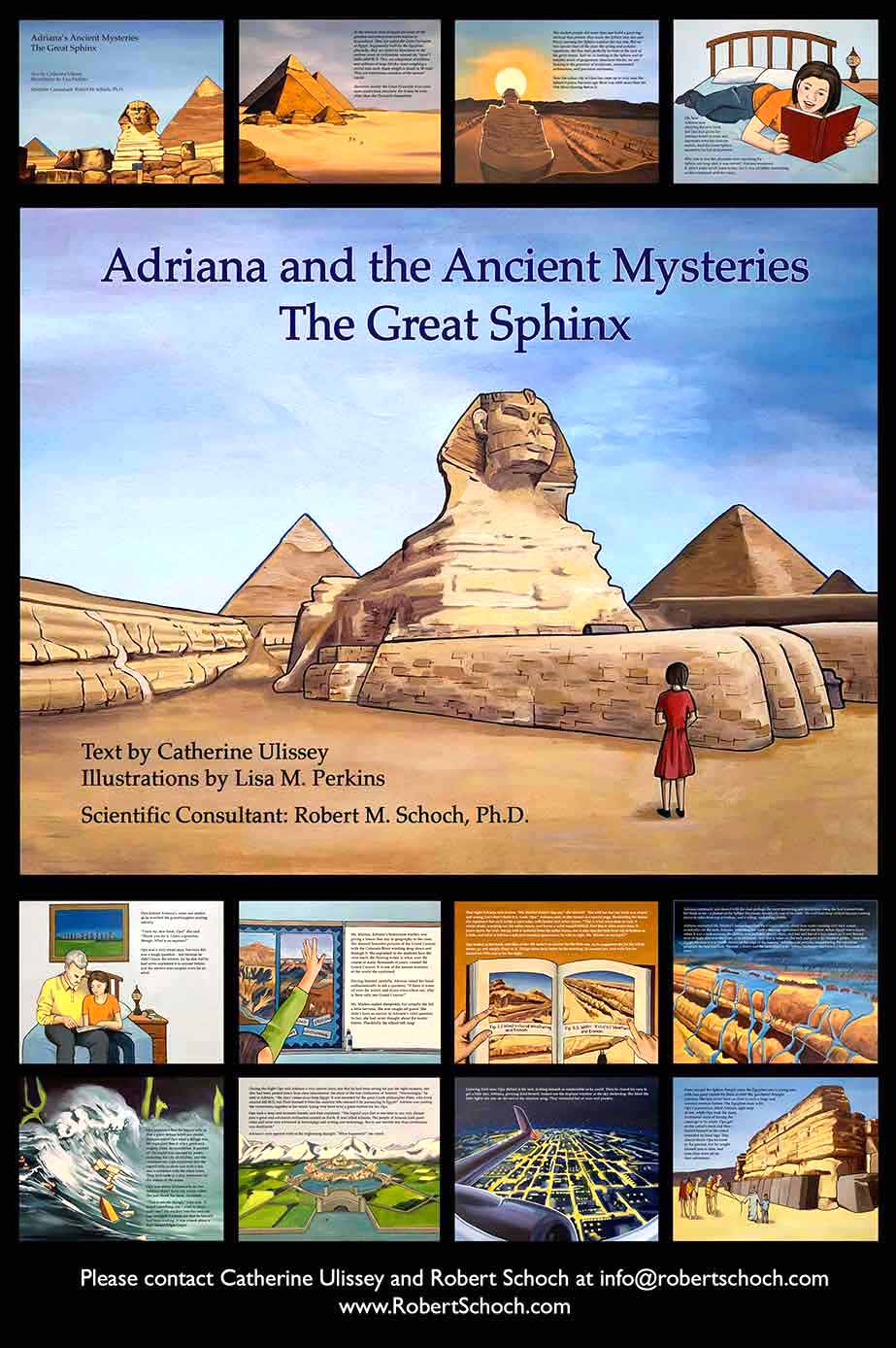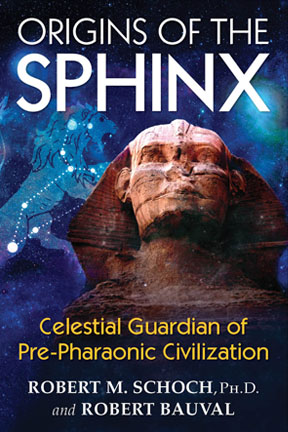Forgotten Civilization: New Discoveries on the Solar-Induced Dark Age
Robert M. Schoch, Ph.D.
with Catherine Ulissey
Inner Traditions (Revised and Expanded, 2021)
The revised and expanded edition of Forgotten Civilization, which bears a new
subtitle, was released in March of 2021. It includes everything in the first edition (see
description of the 2012 release below), plus a new final chapter and various updates to other chapters
throughout the book. Thus, the new edition is approximately 150 pages longer, including over 40 new/additional
photographs. As I detail in this revision, a number of new discoveries made since the first edition
was published reinforce my contention that true civilization existed prior to the end of the last
ice age, some 12,000 years ago, and that civilization was decimated by the solar outburst(s) that
occurred then, throwing humanity into a Solar-Induced Dark Age
for some 6,000 years before
the reemergence of civilization around 4000–3000 BCE. The latest astronomical and astrophysical data
demonstrates just how unstable and erratic our star, our Sun, can be and indeed has been. In 2012
(when the first edition of this book was printed), most astronomers still accepted that our Sun has
been relatively stable
for tens of thousands of years, or longer, but now the paradigm is
changing and the scientific community is slowly realizing that our Sun is a typical star
that undergoes periods of significantly increased and decreased activity on timescales of centuries
and millennia, including both at the end of the last ice age and in modern times. Interestingly,
a micronova
type event 12,000 years ago, which I discuss in this revision and which the data
supports, also explains small impactors
hitting Earth, as a solar explosion could well blast
off dust and debris along with the ionized gases that would (that I believe did) sweep across our
planet. Geology is not so simple! In the updated edition of Forgotten Civilization I also
present a number of other new discoveries and developments, such as the case that the Göbekli Tepe
people had writing, they were literate (a classic hallmark of civilization), and updates on the age
and interpretation of the Great Sphinx of Egypt, including a discussion of the first incarnation of
the statue as the lioness Mehit, guardian of a royal archive that remains hidden beneath her left
front paw. The revised and expanded edition of Forgotten Civilization is available for order on
Amazon and
Barnes & Noble (among other sites).
Please see below for foreign-language editions of the original publication
(Italian, German, Polish, and Romanian). In June 2022 a Spanish-language version of the
revised and expanded edition was released (see below).
Schoch is a true scientist, following the data wherever it leads, heedless of
political pressures or worn-out paradigms. His redating of the Sphinx in 1991 launched
the New Archaeology. Forgotten Civilization distills all that has happened since
into a simple conclusion: that solar activity ended the last cycle of high culture and
may destroy ours in turn. Schoch is no scaremonger, no hawker of a pet theory. What we do
with this knowledge is up to us, but once digested, it changes everything.
– Joscelyn Godwin, Ph.D., Colgate University
Civilización olvidada: Erupciones solares del pasado y del futuro
Robert M. Schoch, Ph.D.
and Catherine Ulissey
Ediciones Luciérnaga (Grupo Planeta), Spain
Katie and I are proud to announce the Spanish edition of Forgotten Civilization. Civilización olvidada was translated from the 2021 (updated and expanded) English-language edition of the book and released in June 2022. It is available from the Book Depository, via the publisher's website, Planeta de Libros, and on Amazon.

Forgotten Civilization: The Role of Solar Outbursts in Our Past and Future
Robert M. Schoch, Ph.D.
Inner Traditions (This is the original, 2012, edition.)
In the original edition of Forgotten Civilization (2012) I briefly recapped over two decades of work on the Great Sphinx of Egypt, but more importantly I presented my research centered on the magnificent Göbekli Tepe complex in Turkey, which confirms my thesis that ancient civilization goes back thousands of years earlier than mainstream historians generally care to acknowledge. I also presented a significant discovery: a reinterpretation of the mysterious rongorongo texts of Easter Island, as the glyphs connect to the work of a prominent plasma physicist. I discussed how solar outbursts and plasma discharges brought about the rapid end of the last ice age and the demise of the early civilizations of that remote period. In the final chapter I presented (and of course all of this remains in the revised and updated edition) some spectacular cutting-edge science that sheds hopeful light on our future. This book (the first/original edition) is still available on Amazon and Barnes & Noble (among other sites), and is out not only in English, but also in Italian, German, Polish, and Romanian. (Note: The foreign language cover designs are different.)
Adriana and the Ancient Mysteries:
The Great Sphinx (Book 1)
Text by Catherine Ulissey
Illustrations by Lisa M. Perkins
Scientific Consultant: Robert M. Schoch, Ph.D.
Publisher: Haapihare Books
The English-language edition of our book is here (revised from two previous foreign-language editions)! The first copies were printed in early June 2024 and made it to the hands and hearts of interested readers just a few days later. Here is the link where anyone in the United States can purchase this book (via Porter Square Books). You can also click the associated image to the right (on this website – or above on phones). This American edition follows German publication in 2021 by Ancient Mail Verlag and Italian publication in 2022 by Harmakis Edizioni. We are working to find outlets where our international fans can obtain the English-language edition.
Publisher's Note: This unconventional picture book, the first in a series that focuses on the ancient mysteries worldwide, introduces young readers to the many mysteries that surround the Great Sphinx, particularly those not discussed in general education regarding the monument. Topics presented include monumental architecture, equinoctial alignment, water- versus wind-weathering of rock, Plato’s Atlantis, Edgar Cayce’s predictions, and more. Containing 44 full-page color illustrations (which makes it a bit more expensive to print than normal picture books), aside from appealing to inquisitive youngsters, Adriana and the Ancient Mysteries: The Great Sphinx is ideal for adults who wish to share with the children in their lives their passion for the ancient mysteries.
Book two of the Adriana and the Ancient Mysteries series, subtitled Göbekli Tepe: 12,000
Years Old, has been written, sketched, and is now being painted. Thank you for your kind support
of this unique (as far as we have been able to determine) endeavor. These are not baby books
; rather,
they are beautifully illustrated picture books (with attention paid to the scientific details and enigmas)
that can be enjoyed by young and old alike (suggested for children ages 7 to 12+ and adults young at heart).
Thanks to Catherine Ulissey for being the first author that I am aware of to write a children's book
about the true story of ancient Egypt. I am sure Zahi Hawass will hate it. :-)
– Dr. Jon Epstein,
sociologist and author
Origins of the Sphinx: Celestial Guardian of Pre-Pharaonic Civilization
Robert M. Schoch, Ph.D., and Robert Bauval
Inner Traditions (2017)
Origins of the Sphinx, co-authored with my friend and colleague Robert Bauval, makes the case, based on multiple lines of evidence (including geological and seismic analyses, astronomical analyses, and interpretations of ancient Egyptian texts), that the origins of the Great Sphinx go back prior to the end of the last ice age (that is, before circa 9700 BCE). I am proud to add that my wife Katie designed the photo insert and co-designed the book's beautiful cover. Origins of the Sphinx is available for order on Amazon and Barnes & Noble, as well as other sites, and is also available in German and Polish editions.
“For a quarter-century, Schoch’s analysis of weathering at Giza and Bauval’s archaeoastronomic discoveries have challenged the consensus on prehistory, not merely of Egypt but of the world. This book expertly summarizes their case and its triumphant vindication in the 12,000-year-old sanctuary of Göbekli Tepe. The question is no longer whether they are right but where archaeology should go from here.” – Joscelyn Godwin, author of Atlantis and the Cycles of Time: Prophecies, Traditions, and Occult Revelations
The Parapsychology Revolution: A Concise Anthology of Paranormal and Psychical Research
Compilation and commentary by Robert M. Schoch, Ph.D., and Logan Yonavjak
Tarcher/Penguin (2008)
The Parapsychology Revolution is an anthology that I put together with Logan Yonavjak. We discuss the serious scientific studies of the paranormal and include selections from fourteen seminal papers, 1886 through 2007, by major figures in the field, plus 100 pages of commentary. For more about my interest in this fascinating field, go to the Research Highlights page on this website.
Pyramid Quest: Secrets of the Great Pyramid and the Dawn of Civilization
Robert M. Schoch, Ph.D., and Robert Aquinas McNally
Tarcher/Penguin (2005)
The focus of Pyramid Quest is the Great Pyramid at Giza, Egypt. I discuss the physical structure of the Great Pyramid and various theories and interpretations as to why it was built and when. Among other things, I believe that the nineteenth-century British astronomer Richard Proctor may have been correct when he hypothesized that the base or lower portion of what was to become the Great Pyramid served as an astronomical observatory before the superstructure was built. (Also published in Russian and Spanish.)
Voyages of the Pyramid Builders: The True Origins of the Pyramids From Lost Egypt to Ancient America
Robert M. Schoch, Ph.D., with Robert Aquinas McNally
Tarcher/Penguin (2003)
Voyages of the Pyramid Builders discusses pyramids around the globe, using this as an entrée to discuss the issue of transoceanic contact in ancient (pre-Columbian) times. After critically analyzing the evidence, I have come to the conclusion that there was contact across both the Atlantic and Pacific Oceans in ancient times. In Voyages I also discuss the impacts and close flybys of comets in historic and prehistoric times that may have affected early civilizations and perhaps spurred long-range migrations. Additionally, I discuss the end of the last Ice Age, the rising sea levels at that time, and the origins of civilization. Voyages includes an appendix titled “Redating the Great Sphinx of Giza.” (Also published in German, Spanish, French, Japanese, Polish, and Czech.)
Voices of the Rocks
Robert M. Schoch, Ph.D., with Robert Aquinas McNally
Harmony (1999)
The focus of Voices of the Rocks is stated succinctly in the subtitle: A Scientist Looks at Catastrophes and Ancient Civilizations. In this book I discuss such topics as Plato’s Atlantis, pole shifts, the Piri Reis map, neo-catastrophism, encounters with comets, the Yonaguni underwater structure, and my work on the age of the Great Sphinx. (Also published in Japanese, Italian, and Spanish.)
Environmental Science: Systems and Solutions, Fourth Edition
Michael L. McKinney, Robert M. Schoch, and Logan Yonavjak
Jones & Bartlett Publishers (2007)
Publisher’s description: The critical importance of environmental preservation is apparent to everyone. The issues facing us today, be they global warming, the depleting ozone layer, the controversy over nuclear power, or the continuing problems of water pollution and solid waste disposal, are headline news. Environmental Science: Systems and Solutions, Fourth Edition, offers the basic principles necessary to understand and address these multi-faceted and often very complex current environmental concerns. The book provides a comprehensive overview and synthesis of environmental science and provides the basic factual data necessary to understand the environment as it is today. It is important that students understand how various aspects of the natural environment interconnect with each other and with human society. Using a systems approach, the authors have organized complex information in a way that highlights these connections in a fair and unbiased fashion. A Study Guide is incorporated at the end of each chapter to help reinforce concepts and provide a clear overview of material. [Six editions of this book have been published.]
Horns, Tusks, and Flippers: The Evolution of Hoofed Mammals
Donald R. Prothero and Robert M. Schoch
The Johns Hopkins University Press (2003)
Publisher’s description: Since the extinction of the dinosaurs, hoofed mammals have been the planet's dominant herbivores. Native to all continents except Australia and Antarctica, they include not only even-toed artiodactyls (pigs, hippos, camels, deer, antelopes, giraffes, sheep, goats, and cattle) and odd-toed perissodactyls (horses and rhinos), but also tethytheres (elephants and their aquatic relatives, manatees and seas cows) and cetaceans (whales and dolphins), which descended from hoofed land mammals. Recent paleontological and biological discoveries have deepened our understanding of their evolution and in some cases have made previous theories obsolete. In Horns, Tusks, and Flippers, Donald R. Prothero and Robert M. Schoch present a compelling new evolutionary history of these remarkable creatures, combining the latest scientific evidence with the most current information about their ecology and behavior.
Using an approach based on cladistics, the authors consider both living and extinct ungulates. Included in their discussion are the stories of rhinos, whose ancestors include both dinosaur-sized hornless species and hippo-like river waders; elephants, whose earliest ancestors had neither tusks nor trunks; and whales, whose descent from hoofed mesonychids has never properly been described for the lay audience. Prothero and Schoch also update the evolutionary history of the horse, correcting the frequent errors made in textbooks and popular works, and they make available to the general public new evidence about the evolution of camels, horned antelopes, and cattle. In addition, they raise important conservation issues and relate anecdotes of significant fossil finds.
Scientifically accurate and up to date, generously illustrated, and clearly written, Horns, Tusks, and Flippers is a useful and much-needed resource for specialists in the fields of paleontology, zoology, ecology, and evolutionary biology, as well as for general readers interested in learning more about the story of life on Earth.
Major Features of Verterbrate Evolution: Short Courses in Paleontology Number 7
Edited by Donald R. Prothero and Robert M. Schoch
Paleontological Society (1994)
A technical edited volume that compiles a number of important contributions, by specialists in the field, concerning the evolution of vertebrates, from fishes to mammals.
The Evolution of Perissodactyls
Edited by Donald R. Prothero and Robert M. Schoch
Oxford University Press (1989)
Publisher's description (excerpt): This new treatise [new in 1989] is comprised of 24 papers covering virtually every recent development regarding fossil horses, rhinos, tapirs, and their extinct relatives. It includes materials currently available in no other reference, such as information on the oldest known rhino and the oldest known perissodactyl, as well as papers debunking myths about the evolution of horses, and strong evidence that hyraxes are not related to elephants. The summary chapter includes useful charts which show the relationships of all perissodactyl genera, their distribution in time and space, and a new classification of the order.
Stratigraphy: Principles and Methods
Robert M. Schoch
Van Nostrand Reinhold Company (1989)
Publisher's description (excerpt): What is stratigraphy? How do we arrive at stratigraphic knowledge? And how do we express stratigraphic hypotheses and conclusions? Heated discussions of such basic issues as fundamental principles, terminology, definitions, and classifications continue to pervade the stratigraphic community. In fact, stratigraphy seems to be a science in which there are often more questions than answers.
Stratigraphy: Principles and Methods now provides the best general overview of classical stratigraphy and its philosophical underpinnings currently available. This outstanding reference and text fills the need for an unbiased yet critical analysis of the present state of the discipline.
The volume first offers you a definition of stratigraphy and a review of the development of stratigraphic thought. You'll see how stratigraphic knowledge is derived from the physical rock record, and you'll get brief descriptions of modern methodology.
Fundamental concepts such as uniformitarianism,
unconformity,
and correlation
are clearly explained. And various types of stratigraphic
units – lithostratigraphic, lithodemic, pedostratigraphic, allostratigraphic,
and hydrostratigraphic – are distinguished and explored.
Phylogeny Reconstruction in Paleontology
Robert M. Schoch
Van Nostrand Reinhold Company (1986)
How do we reconstruct phylogeny, evolutionary relationships, and classify fossil organisms? These are central issues addressed in this book, both from a pragmatic and from a philosophical perspective.
Vertebrate Paleontology
Compiled and edited by Robert M. Schoch
Van Nostrand Reinhold Company (1984)
This anthology reprints twenty-two classic papers, spanning the period from 1815 to 1973, essential to a full understanding of the historical background of the field of vertebrate paleontology (the study of fossil animals with backbones). Also included are my introductions and commentaries on the articles and the field in general, including an overview and classification of vertebrates.
Systematics, Functional Morphology and Macroevolution of the Extinct Mammalian Order Taeniodonta
Robert Milton Schoch
Yale University Peabody Museum (1986)
This is the published version of my Ph.D. dissertation (I received my Ph.D. from Yale University in 1983). It is a study of the extinct group of mammals, known as the Taeniodonta, who lived some 45 to 65 million years ago. I am honored to be among the select few over the years who have had their dissertations published by the Yale Peabody Museum.
















